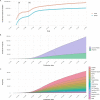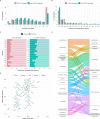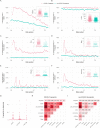The evolving role of preprints in the dissemination of COVID-19 research and their impact on the science communication landscape
- PMID: 33798194
- PMCID: PMC8046348
- DOI: 10.1371/journal.pbio.3000959
The evolving role of preprints in the dissemination of COVID-19 research and their impact on the science communication landscape
Abstract
The world continues to face a life-threatening viral pandemic. The virus underlying the Coronavirus Disease 2019 (COVID-19), Severe Acute Respiratory Syndrome Coronavirus 2 (SARS-CoV-2), has caused over 98 million confirmed cases and 2.2 million deaths since January 2020. Although the most recent respiratory viral pandemic swept the globe only a decade ago, the way science operates and responds to current events has experienced a cultural shift in the interim. The scientific community has responded rapidly to the COVID-19 pandemic, releasing over 125,000 COVID-19-related scientific articles within 10 months of the first confirmed case, of which more than 30,000 were hosted by preprint servers. We focused our analysis on bioRxiv and medRxiv, 2 growing preprint servers for biomedical research, investigating the attributes of COVID-19 preprints, their access and usage rates, as well as characteristics of their propagation on online platforms. Our data provide evidence for increased scientific and public engagement with preprints related to COVID-19 (COVID-19 preprints are accessed more, cited more, and shared more on various online platforms than non-COVID-19 preprints), as well as changes in the use of preprints by journalists and policymakers. We also find evidence for changes in preprinting and publishing behaviour: COVID-19 preprints are shorter and reviewed faster. Our results highlight the unprecedented role of preprints and preprint servers in the dissemination of COVID-19 science and the impact of the pandemic on the scientific communication landscape.
Conflict of interest statement
I have read the journal’s policy and the authors of this manuscript have the following competing interests: JP is the executive director of ASAPbio, a non-profit organization promoting the productive use of preprints in the life sciences. GD is a bioRxiv Affiliate, part of a volunteer group of scientists that screen preprints deposited on the bioRxiv server. MP is the community manager for preLights, a non-profit preprint highlighting service. GD and JAC are contributors to preLights and ASAPBio fellows.
Figures






Similar articles
- Preprint manuscripts and servers in the era of coronavirus disease 2019.J Eval Clin Pract. 2021 Feb;27(1):16-21. doi: 10.1111/jep.13498. Epub 2020 Oct 23.J Eval Clin Pract. 2021.PMID: 33094906
- Characterization and Reach of Orthopaedic Research Posted to Preprint Servers: Are We "Undercooking" Our Science?Clin Orthop Relat Res. 2023 Aug 1;481(8):1491-1500. doi: 10.1097/CORR.0000000000002621. Epub 2023 Mar 10.Clin Orthop Relat Res. 2023.PMID: 36897188Free PMC article.
- Tracking changes between preprint posting and journal publication during a pandemic.PLoS Biol. 2022 Feb 1;20(2):e3001285. doi: 10.1371/journal.pbio.3001285. eCollection 2022 Feb.PLoS Biol. 2022.PMID: 35104285Free PMC article.
- Preprint Servers in Kidney Disease Research: A Rapid Review.Clin J Am Soc Nephrol. 2021 Mar 8;16(3):479-486. doi: 10.2215/CJN.03800320. Epub 2020 Jul 17.Clin J Am Soc Nephrol. 2021.PMID: 32680914Free PMC article.Review.
- Preprint servers in lipidology: current status and future role.Curr Opin Lipidol. 2022 Apr 1;33(2):120-125. doi: 10.1097/MOL.0000000000000797.Curr Opin Lipidol. 2022.PMID: 34699388Review.
Cited by
- Preprint pointers from a long COVID scoping review: considerations for source selection and searching.J Can Health Libr Assoc. 2024 Aug 1;45(2):88-97. doi: 10.29173/jchla29741. eCollection 2024 Aug.J Can Health Libr Assoc. 2024.PMID: 39430651Free PMC article.
- Identifying factors contributing to increased susceptibility to COVID-19 risk: a systematic review of Mendelian randomization studies.Int J Epidemiol. 2022 Aug 10;51(4):1088-1105. doi: 10.1093/ije/dyac076.Int J Epidemiol. 2022.PMID: 35445260Free PMC article.
- Open access and its potential impact on public health - A South African perspective.Front Res Metr Anal. 2022 Dec 2;7:975109. doi: 10.3389/frma.2022.975109. eCollection 2022.Front Res Metr Anal. 2022.PMID: 36531754Free PMC article.Review.
- Current Status of Neurointervention, the Official Journal of the Korean Society of Interventional Neuroradiology.Neurointervention. 2022 Jul;17(2):67-69. doi: 10.5469/neuroint.2022.00297. Epub 2022 Jun 24.Neurointervention. 2022.PMID: 35746835Free PMC article.No abstract available.
- Science Communication and Biomedical Visualization: Two Sides of the Same Coin.Adv Exp Med Biol. 2023;1421:3-13. doi: 10.1007/978-3-031-30379-1_1.Adv Exp Med Biol. 2023.PMID: 37524981
References
- WHO. COVID-19 Weekly Epidemiological Update-11. 2020 Oct. Available from: https://www.who.int/docs/default-source/coronaviruse/situation-reports/w....
- WHO. Coronavirus Disease (COVID-19) Weekly Epidemiological Update—24. 2021 Jan. Available from: https://www.who.int/docs/default-source/coronaviruse/situation-reports/2...
Publication types
MeSH terms
Grants and funding
LinkOut - more resources
Full Text Sources
Other Literature Sources
Medical
Miscellaneous

